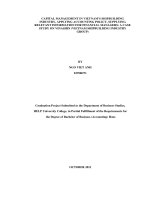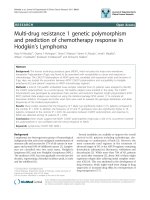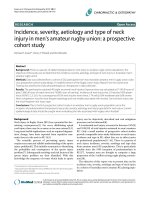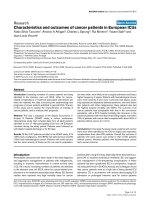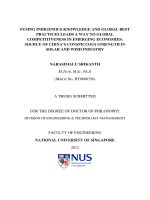Antecedents and outcomes of customer incivility a study of frontline employees in vietnam’s retail industry
Bạn đang xem bản rút gọn của tài liệu. Xem và tải ngay bản đầy đủ của tài liệu tại đây (863.58 KB, 82 trang )
UNIVERSITY OF ECONOMICS HO CHI MINH CITY
International School of Business
------------------------------
Bùi Xuân Quỳnh
ANTECEDENTS AND OUTCOMES OF
CUSTOMER INCIVILITY:
A STUDY OF FRONTLINE
EMPLOYEES IN VIETNAM’S RETAIL
INDUSTRY
MASTER OF BUSINESS ADMINISTRATION
Ho Chi Minh City – Year 2018
1
UNIVERSITY OF ECONOMICS HO CHI MINH CITY
International School of Business
------------------------------
Bùi Xuân Quỳnh
ANTECEDENTS AND OUTCOMES OF
CUSTOMER INCIVILITY:
A STUDY OF FRONTLINE
EMPLOYEES IN VIETNAM’S RETAIL
INDUSTRY
MASTER OF BUSINESS ADMINISTRATION
SUPERVISOR: Dr. NGUYỄN THỊ MAI TRANG
ID: 22150054
Ho Chi Minh City – Year 2018
2
Acknowledgement
Apart from the efforts of me, the on time completion of the thesis largely on the
encouragement and guidelines of many others. I take this opportunity to express my
gratitude to the people who have been instrumental in the successful completion of this
thesis.
I would like to express my appreciation to Dr. Nguyễn Thị Mai Trang – my
instructor. She provided me with tremendous support, help and motivations. Without her
instructions and guidance, I would not materialized this thesis.
The guidance and supports received from ISB, classmates, friends and family are
also very important to me. I am grateful for their constant support and help.
3
Antecedents and outcomes of customer incivility:
A study of frontline employees in Vietnam retail industry
Abstract
One of the big challenges of retail industry is improve the service quality to catch up with
the growth of economics. In order to improve the service quality, mandatory corporate
emotional expression rules commonly employed; which is in turn, affect the frontline
employee emotional well-being and increase turn-over intention – another big challenge
of retail industry. Workplace incivility and emotional labor somehow exist in the middle
of this conflict; where they have been attended by researchers, and receiving more
attention as its practical potential and importance. The study examined five constructs
including: experienced supervisor incivility, experienced co-worker incivility, customer
incivility, emotional labor and quality of work life; which are possible antecedents,
mediators and outcome of customer incivility. A face-to-face survey with the target of
300 valid samples conducted with frontline employees in Ho Chi Minh City, Vietnam.
The results support all hypotheses; whereas experienced supervisor incivility and
experienced co-worker incivility are antecedents of customer incivility; customer
incivility is found related to quality of work life – a non-negative outcome. Surface acting
and deep acting, the two dimensions of emotional labor are found as mediators in the
relation between customer incivility and quality of work life with inconsistent effects
addressing the importance of workplace incivility and positive roles of emotional labor
which further study should attend.
4
Table of Contents
1. Introduction ................................................................................................................... 7
2. Theoretical background and hypotheses .................................................................... 13
2.1 Customer incivility and its antecedents ................................................................. 13
2.2 Emotional labor ...................................................................................................... 21
2.2 Quality of work life ................................................................................................ 24
3. Research method ........................................................................................................ 25
3.1 Procedure and sample ............................................................................................. 25
3.2 Measurements ........................................................................................................ 26
3.3 Data collection ....................................................................................................... 27
3.4 Measurement refinement ........................................................................................ 28
4. Data analyses results ................................................................................................... 30
4.1 Confirmatory Factor Analysis ............................................................................... 30
4.2 Hypotheses testing – Structural Equation Model (SEM) ....................................... 31
5. Discussion .................................................................................................................. 33
5.1 Implications for theory and research ..................................................................... 35
5.2 Implications for managers ..................................................................................... 37
5.3 Conclusions ........................................................................................................... 38
5.4 Limitations and implications for future research .................................................. 38
6. Support information .................................................................................................... 40
6.1 Qualitative data collection procedures, guidelines and transcripts ....................... 40
6.2 English questionnaire ............................................................................................ 63
6.3 Vietnamese questionnaire ...................................................................................... 67
6.4 Analyses results ..................................................................................................... 71
References ........................................................................................................................ 73
5
List of figures and tables
Table 1: Recent studies of workplace incivility antecedents .......................................... 18
Figure 1: Research model ................................................................................................. 24
Table 2: Sample characteristics ....................................................................................... 27
Table 3: Data collection ................................................................................................... 28
Table 4: EFA results ........................................................................................................ 29
Table 5: CFA Model fit ................................................................................................... 31
Table 6: Validity ............................................................................................................... 31
Table 7: SEM Model fit ................................................................................................... 32
Table 8: Structural paths – SEM ..................................................................................... 32
Table 9: Mediation tests ................................................................................................... 33
6
1. Introduction
Retail industry holds a very important part in the economic; in 2016, total retail sales
worldwide estimated to reach 22.049 trillion US$ and forecasted to continue to grow
(“Total retail sales worldwide, 2015-2020 (trillions and % change)”, 2017). As other
industries, retail industry facing multiple challenges; which two noticeable challenges are
the necessity to improve the retail service quality when the growth of economics pushing
the growth of retail industry (Vargo, Maglio, & Akaka, 2008), and retaining salespeople
or service employees, who interact face-to-face with customers and often referred to as
frontline employees, as high turnover is recognized as critical problem to the industry
(Freemen, 2017; Kern & Grandey, 2009; Han, Bonn, & Cho, 2016). In order to improve
the retail service quality, retailers often apply strict and strong mandatory emotion
expression rules to their frontline employees; however, mandatory emotion expression
rules often associate with faking emotions which may negatively affect the frontline
employees and reduce the job outcomes of frontline employees, increase turnover
intention (Grandey, 2003; Kim, Jung-Eun Yoo, Lee, & Kim, 2012).
The retail industry of Vietnam shows quite similarities; where the economy is
forecasted to continue to grow (Thanh Thom, 2017), and considered as a transition
market which in the world’s top 30 countries with most attractive retail market. Vietnam
industry revenue of 2017 is estimated to reach almost 130 billion US$ (Hùng Lê, 2018);
and holds at least 50% of total businesses registered and employs almost three million
labors (Nguyên Vũ, 2016), in which a large portion of these employees are working at the
frontline and providing services to customer directly with face-to-face contact. High
7
turnover is addressed as a critical challenge to Vietnam retailers, results of a recent
survey show that 28% of employers in retail industry find frontline employees not have
long-term commitment and 49% address that frontline employees are not persistent when
approached by another retail employer (Nam Dương, 2017). Vietnam retailers also
employ mandatory emotion expression rules for their frontline employees to improve
retail service quality; and not an exception, Vietnam retailers still not yet paid sufficient
attention to the affects maybe produced and harm their business as well as the well-being
of their frontline employees.
Concern the negative effects on the well-being of frontline employees; in 2016,
there are many cases of customer aggressions made the news in Vietnam (Quốc Huy,
2016; Hoàng Đan, 2016; Tuấn Phùng, 2016); these are highlighted physical aggressive
actions where the customers punched and slabbed the frontline employees which involve
single or few individuals where the victims (frontline employees) were traumatized
and/or hospitalized; the lower intensity cases which involve large crowd of Vietnamese
were gone unreported. However, when using keywords “Supermarket culture of
Vietnamese” searching on the internet, the results will show multiple news articles on the
“bad habits” or “bad behavior” of Vietnamese in supermarket or public places (Bảo
Phương, 2016; Thu Hà, 2016; T.Anh, 2012), which mostly concern the “uncivilized”
behavior of Vietnamese in supermarket and public places through the viewpoint of other
customers upon the occurrence of their discomforting emotions in such circumstances.
Though, they are customers, they only experience these behaviors occasionally;
meanwhile, supermarket employees or more broadly – frontline employees are possibly
8
have to experience these behaviors with a much higher frequency. These behaviors are
considered as “interpersonal mistreatment” and “sub-form of counterproductive”
(Vagharseyyedin, 2015, p. 116); which often addressed as workplace incivility and
recognized as counterproductive work behavior which reduce the productivity of the
organization and employee (Fox, Spector, & Miles, 2001; Anderson & Pearson, 1999).
Evidences of the negative relationship between workplace incivility and employee’s wellbeing have been found in multiple industries and contexts (Cortina, Magley, Williams, &
Langhout, 2001; Han, Bonn, & Cho, 2015), and “comparable with low intensity stress”
which can have emotionally and physically negative effect (Han et al., 2016). Customer
incivility is identified as one of the negative factors which relates to the use of emotion of
frontline employees and increase turnover intention; which has been gathered substantial
attention of researchers (Grandey, 2003; Han et al., 2016).
The incivility behavior occurred in workplace has not been well attended, and
Vietnam is not an exception; because the corporate as well as the employee are not fully
aware of its harmful potential to the whole organization (Torkelson, Holm, Backstrom, &
Schad, 2016). Furthermore, the incivility behavior could be produced due to the lack of
norms of civility and uncivility (Walsh, Magley, Reeves, Davies-Schrils, Marmet, &
Gallus, 2012); especially in a growing market like Vietnam where the retail service
quality standard is continuously increased. Workplace incivility is studied by researchers
under three dimensions: supervisor incivility, co-worker incivility and customer
incivility; recently, the suggestion of “family incivility” and “employee incivility” by
Hur, Moon, and Han (2015, p. 407); and Walker, Jaarsveld, and Skarlicki (2014).
9
Previous studies found noticeable effects of customer incivility on frontline service
employees (Cho, Bonn, Han, & Lee, 2016; Han et al., 2016; Laschinger, Leiter, Day, &
Gilin, 2009; Hur et al., 2015); the related factors studied as increase turnover intention
(Han et al., 2016), decrease service performance (Cho et al., 2016), recruitment and
retention (Laschinger et al., 2009).
The studies of customer incivility have been conducted in Asia countries such as
Korea (Cho et al., 2016), China (Chen, Ferris, Kwan, Yan, Zhou, & Hong, 2013),
Malaysia (Santos, Mustafa, & Gwi, 2014), and Thailand (Akkawanitcha, Patterson,
Buranapin, & Kantabutra, 2014) where negative effects are found. However, only little
studies attempted to find the antecedents of workplace incivility and especially customer
incivility (Hershcovis & Barling, 2010; Bartlett, Bartlett, & Reio, 2008; Lanzo, Aziz, &
Wuensch, 2015; Hur, Moon, & Jun, 2016). Lanzo et al. (2015, p. 175) note “An
examination of the antecedents of workplace incivility is a novel area of study”, “did not
address the question who likely to be uncivil as a result of stress” and future research
should examine the instigator of the workplace incivility.
Workplace incivility is proved to have strong relation with emotional exhaustion
and mediated by surface acting and deep acting which are the two dimensions of
emotional labor (Hur et al., 2015). Decreasing in service performance, increase turnover
intention, and reducing organization commitment are studied outcomes of customer
incivility (Cho et al., 2016). Emotional labor concept was initiated by Hochschild (1983),
which is a form of emotional regulation but different to emotional intelligent; and
previously proved to have negative effects on individual (employee) as well as
10
organization (Hwa, 2012). Previous study conceptualizes surface acting and deep acting
are two dimensions of emotional labor; and findings support the stronger negative effect
of surface acting on emotional exhaustion than deep acting (Brotheridge & Grandey,
2002; Grandey, 2000; Hwa, 2012; Hur et al., 2014). Grandey (2000, p. 97) posits
emotional labor as the process where employee managing their “feelings and
expressions” toward the goal set by the organization.
Emotional labor and emotional exhaustion proved by prior studies to have strong
relation (Grandey, 2003; Grandey & Frone, 2007); and both emotional labor and
emotional exhaustion found related to employee outcomes and employee well-being;
which in turn are work attitudes, job performance, organization citizenship, affective
commitment, job satisfaction, customer service performance, organization commitment,
and turnover intention (Cho et al., 2016; Sliter, Jex, Wolford, & McInnerney, 2010; Hur
et al., 2014; Walsh et al., 2015; Cropanzano, Rupp, & Byrne, 2003). On the other hand;
Sirgy et al. (2001, p. 242) define quality of work life as “employee satisfaction with a
variety of needs through resources, activities and outcomes stemming from participation
in the workplace”; and suggest that quality of work life “may have a significant impact
on employee behavioral responses, such as organizational identification, job
performance, intention to quit, organization turnover, personal alienation” (Sirgy et al.,
2001, p. 242). Quality of work life was first introduced by Hackman & Oldham (1976)
and received large amount of attention where the authors referred as “quality of working
life”.
11
Contradiction in the viewpoints of employers and employees in retail industry
revealed in a recent survey in Vietnam, employees have concern on organization culture
(99%) through working environment, human factors, and organization vision; meanwhile
51% of the interviewed employers see the compliance with the organization culture is
mandatory and 40% are not (Nam Dương, 2017). Mandatory compliance with
organization culture often associate with strong mandatory emotional expression rules.
Factors related to quality of work life also found as reasons to turnover; recent reports
show 22% of the correspondents turned over due to low wages and promotion problems
(Nam Dương, 2017; Ngân Anh, 2017).
Other prior studies found support for the relationship between job performance
and quality of work life (Nguyễn & Nguyễn, 2012; Koonmee & Virakul, 2012; Sirgy,
Efraty, Stegel, & Lee, 2001); and a prior study successfully examined quality of work life
as a mediator between emotional labor and work family interference (Cheung & Tang,
2009); this would be a further evidence for the direct relationship between emotional
labor and quality of work life. Based on the similarities in the founded relations of
workplace incivility, customer incivility, emotional labor, emotional exhaustion, and
quality of work life; the study would argue that this would be a sufficient basis to test the
direct relationship from customer incivility to emotional labor and emotional labor to
quality of work life, and the possible mediating effect of emotional labor between
customer incivility and quality of work life in the context of frontline employee in Hồ
Chí Minh City, Vietnam.
The next part provides theoretical background and development of hypotheses.
12
2. Theoretical background and hypotheses
2.1 Customer incivility and its antecedents
The term “civility” was posited as standards of behavior and speech to maintain the wellbeing of individual during his or her interactions with another individual; therefore, in
order to benefits from the interactions, this individual shall have the obligations to be
“civilized” for the well-being of the other individual at the same time (Vagharseyyedin,
2015). Inappropriate actions and behavior of an individual or customer may lead to the
interpretation of “insulting and degrading verbal and nonverbal conduct”
(Vagharseyyedin, 2015, p. 116).
Incivility in workplace has raised the concern of scholars from around the world
within the last two decades (Schilpzand, Pater, & Erez, 2014; Cho et al., 2016; Han et al.,
2016; Laschinger et al., 2009; Anderson & Pearson, 1999; Cortina et al., 2001; Walsh,
Magley, Reeves, Davies-Schrils, Marmet, & Gallus, 2012). Incivility definition posited
by Anderson & Pearson (1999) is considered as the foundation for the study of workplace
incivility (Cho et al., 2016; Han et al., 2016; Laschinger et al., 2009; Cortina et al., 2001;
Walsh et al., 2012); which is “like aggression, but one that is less intense and ambiguous
as intent to harm” (p. 457). Workplace incivility therefore consists of two characteristics,
first is the “low intensity of the behavior” and the second is the “ambiguous intent”;
therefore, when the intent to harm the other becomes clear with high intensity, it would
be considered as act of aggression not incivility (Vagharseyyedin, 2015, p. 118). Previous
studies notice incivility as antisocial behaviors and overlap with aggression and bullying;
13
“there is certain degree of overlap between workplace incivility and workplace bullying”
(Torkelson et al., 2016, p. 118).
Schilpzand et al. (2016) summarize that the study of incivility have been
conducted around the globe as it is recognized as a global phenomenon not just one or
two specific cultures or countries; and the incivility in workplace has been studied and
tested “from a wide variety of jobs and professions” (Schilpzand et al., 2016, p. 61).
Early study of workplace incivility mostly concern the internal interactions of the
workplace, which includes supervisor incivility and co-worker incivility; customer
incivility only started to be examined recently, and significant impacts on frontline
employee were found (Han et al., 2016; Cho et al., 2016). The negative outcomes of
incivility in workplace have been found in previous studies as turnover intention,
decrease job performance, decrease service performance, recruitment and retention. The
antecedents of workplace incivility not yet received sufficient attention, even though the
understanding of antecedents would help managers preventing the workplace incivility to
reduce its harmful effects on employee as well as the whole organization (Hur et al.,
2016). Because of the “ambiguous” and “less intense” of the incivility and the overlap
between incivility and bullying, aggression; researchers attempted to study its
antecedents through examining the antecedents of bullying; (Torkelson et al., 2016, p.
118) note “research on bullying is relevant when considering antecedents of workplace
incivility” and “bullying cause mental distress and that mental distress led to bullying”.
Researchers often address the parties involved in a workplace incivility incident as
perpetrator, target, instigator and victim; workplace incivility includes supervisor
14
incivility, co-worker incivility, customer incivility, family incivility and employee
incivility (Schilpzand et al., 2016; Cho et al., 2016; Han et al., 2016; Laschinger et al.,
2009; Anderson & Pearson, 1999; Cortina et al., 2001; Walsh et al., 2012; Bartlett et al.,
2008; Torkelson et al., 2016; Hur et al., 2016; Hur et al. 2015; Walker et al., 2014).
Schilpzand et al. (2016) summarizes incivility by the initiating party as supervisor, coworker, customer, family member, and employee; and by the types which includes
experienced, witnessed and instigated incivility.
Previous studies address the uncivil spiral, which mean the escalation of incivility
from the moment it is instigated and possibly led to aggression or even violence; where
both parties are negatively affected (Anderson & Pearson, 1999; Holm, Torkelson, &
Backstrom, 2015; Lim et al., 2008; Hershcovis & Barling, 2010). However, there are
possibilities that the perpetrator or instigator become the target or victim of his/her own
initiated incivility behavior. The chance to become victim of incivility behavior would be
depended on the power position of the involved parties and who is holding the lower
position. Therefore, employee would be the victim of their own incivility behavior when
evoking “power imbalance between customers and service employees” and “customers
often take advantages of their position and increasingly abuse their power” (Hur et al.,
2014, p. 395) ignoring the fact that the incivility instigated by employee or customer.
The examining of antecedents of workplace incivility attempted concern the
incident occurred inside an organization between supervisor-subordinate/employee
(supervisor incivility) and employee-employee (co-worker incivility), little attention to
examine the antecedents of workplace incivility between employee-outsider
15
(employee/customer incivility) (Hur et al., 2016). The main different between
employee/customer incivility and supervisor incivility, co-worker incivility that the
perpetrator or instigator does not acquainted with the target or victim, which mean the
employee encounters incivility with “a total stranger”. On the other hand, the impact or
perception of incivility with supervisor or co-worker would be mediated or moderated by
the knowledge of the perpetrator or instigator about the target or victim and vice versa, or
common understanding of the workplace environment.
For more than a decade, researchers have been examined antecedents of workplace
incivility from multiple perspectives: distributive injustice, job dissatisfaction, and work
exhaustion (Blau & Anderson, 2005); beliefs and personality of workers, organization
downsizing, structure and environment (Bartlett et al., 2008); workaholism (Lanzo et al.,
2015). In Abid, Khan, Rafiq and Amed (2015) study, twenty one antecedents of
workplace incivility were summarized and examined; in which customer incivility was
examined as antecedent of workplace incivility. However, there is still little literature on
antecedents of customer incivility (Hur et al., 2015; Lanzo et al., 2015); Hur et al. (2014,
p. 407) notice “limitation of this study is that supervisor or coworker incivility should
also be explicitly examined as other sources of incivility that might have an even greater
effect on employees’ psychological well-being and customer-related outcomes”.
A conceptual study by Bartlett et al. (2008, p.3, 4) divide antecedents of
workplace incivility into two groups; first is the “antecedents for workers” which
“include beliefs and personality”:
16
Beliefs include expected benefits, perceived job insecurity, dissatisfaction,
attitudes about aggression, and low perceived cost for inappropriate behaviors (Salin,
2003). Personality is also a motivator for incivility. Type A personality, trait aggression,
hostility, power, ego, and internal competition are all personality traits that can motivate
uncivil behavior (Cortina et al., 2001; Glendinning, 2001; Hornstein, 2003; Salin, 2003).
(p.3)
Second is “antecedents for organization” which include “downsizing”, “structural
antecedents” and “environmental antecedents”:
Other structural antecedents for organizations found in the literature were
reengineering (Anderson & Pearson, 1999), hierarchical structuring (Muir, 2000), use of
part time employment (Anderson & Person, 1999; Vickers, 2006), organizational change
(Salin, 2003; Vickers, 2006), and globalization (Gardner & Johnson, 2001; Muir, 2000).
Environmental antecedents for organizations included autocratic work environments,
difficult working conditions, and an anxiety ridden workplace (work atmosphere)
(Anderson & Pearson, 1999; Gardner & Johnson, 2001; Indvik, 2001; Muir, 2000; RauFoster, 2004). (p. 4, 5)
In line with Bartlett et al. (2008) study, an empirical study by Torkelson et al.
(2016, p. 119) examined and found support for the relationship between organizational
variables and incivility. This study also examined found the support for the “possible
antecedent to perpetrating incivility” as being victimized, whereas the correspondents see
themselves as perpetrator and victim at the same time which “triggered a sense of
retaliation” and may create a “spiral”.
17
Table 1: Recent studies of workplace incivility antecedents
Study
Antecedents
Outcomes
Method
(Location)
Findings
Job stress
Asserting power on
other colleague
Perception of
distributive,
procedural and
interactional justice
Job dissatisfaction
Lack of
professional,
disrespectful
environment
Power and social
status
Job exhaustion
Abid et al.
(2015)
High stress
environment
Workplace
Incivility
Job security
Interest conflict and
status-based social
enclosure
Gender harassment
Emotional
exhaustion
Gender diversity
(misunderstanding)
Job demands
Sexualized
harassment
Organizational
chaos (enhance
through downsizing,
18
“Almost every
Employees
individual at
from various
workplace is a Victim
sectors in
of workplace
Lahore
incivility”. (p. 6310)
region
outsourcing and
most centrally
Customer Incivility
Workload
Workplace
adaptation
Hostile workplace
Affective experience
Walker et
al. (2014)
Individual Customer
Incivility
Employee
Incivility
Customer
service
employees
in Central
Canada
Workplace
incivility target
related outcomes
Vagarseyyedi
n (2015)
Schilpzand
et al.
(2016)
Individual factors
Organizational
factors
Dispositional
antecedents of
experienced
incivility
Workplace
incivility witnessrelated outcomes
Workplace
incivility
organizational
and community
related outcomes
Affective
outcomes of
experienced
incivility
19
Concept
analysis
Clinical
environme
nt
Literature
review
“Employees react to
uncivil event by
engaging in
incivility”;
“employees respond
to event customer
incivility as a function
of their accumulated,
entity perceptions of
incivility in customer
interactions”. (p. 158)
“Workplace incivility
is a phenomenon in
which specific
personal and
organizational factors
are involved and can
have negative
outcomes for the
victims, witnesses,
organizations, and
probably the
perpetrators
themselves”. (p. 123)
“Most research on
incivility focuses on
experienced incivility
(45 out of 55 papers)
and, more
Behavioral
antecedents of
experienced
incivility
Attitudinal
outcomes of
experienced
incivility
Situational
antecedents of
experienced
incivility
Cognitive
outcomes of
experienced
incivility
Witnessed incivility
Behavioral
outcomes of
experienced
incivility
Instigated incivility
Bartlett et
al. (2008)
Lanzo et
al. (2015)
Antecedents for
workers: variables
that facilitating
incivility; enablers,
motivators, and
triggers
Antecedent for
organizations:
structural
environmental, and
outlying
Workaholism
Outcomes for
Workers:
individual,
interpersonal
relationships, and
productivity
Outcomes for
organizations:
financial impact,
administrative,
and
environmental
Incivility
20
specifically, on the
various outcomes for
targets of uncivil
conduct”. (p. S67)
“Workplace incivility
has definite impacts
on workers in terms
of productivity,
health, attitudes, and
relationships.
Finance, environment,
Integrative
structure, and
review
administration are
categories of
variables at the
organizational level
that are affected by
acts of workplace
incivility”. (p. 6; 9-3)
“Participants who
reported higher levels
of stress and lower
Employees
levels of PsyCap were
from
more likely to engage
various
organizatio in uncivil behaviors,
regardless of their
ns and
workaholism score.
industries
Furthermore,
in Eastern
workaholics
reported
USA
higher levels of stress,
lower levels of
PsyCap, and engaging
in workplace
incivility. Overall,
workaholism and
stress increased
incivility, while
PsyCap decreased it”.
(p. 176)
The study bases on reviewed literature of workplace incivility and customer
incivility would argue that the incivility incident between employee and customer would
have negative effects on both parties and employee will likely to become victim (who
receive higher level of negative effect) of the incivility instigated by themselves due to
the employee-customer power imbalance; and refers the incident as “customer incivility”.
In line with previous studies and the suggestion by Hur et al. (2015); the study examines
the possibilities of which the incivility from persons working together in an organization
may trigger the incivility between the person working in that organization and an
outsider.
H1: Experienced Supervisor Incivility is positively related to Customer Incivility.
H2: Experienced Co-worker Incivility is positively related to Customer Incivility.
2.2 Emotional labor
Brotheridge and Grandey (2002), and Brotheridge and Lee (2003) posit that emotional
labor consists of two dimensions, surface acting and deep acting; and the employment of
the emotional labor strategies may negatively affect employee and increase emotional
exhaustion. Other empirical research confirms this proposition and point out that surface
acting have negative effect on employee; meanwhile, deep acting may have positive
21
effect (Han et al., 2016; Cho et al., 2016; Hur, Han, Yoo, & Moon, 2014; Santos, et al.,
2014; Walsh, Dahling, Schaarschmidt, & Brach, 2016; Cho et al., 2017; Hwa, 2012). On
the other hand; Lewig and Dollard (2003, p. 368) sees emotional labor as a tool with both
negative and positive effect, as “emotional labor can serve to facilitate task effectiveness”
and “emotional labor can become dysfunctional for the worker when dissonance between
felt emotions and displayed emotions is experienced”. In other words, when frontline
service employee fake his or her emotion in order to cope with the circumstances set-out
by the incivility of customer, it will damage the emotions of the employee. The emotional
labor strategy employed by the employee will affect his or her own well-being (Cho et
al., 2017). One of the most studied negative outcomes of workplace incivility is
emotional exhaustion (Han et al., 2016; Cho et al., 2016; Laschinger et al., 2009). In Han
et al. (2015), Cho et al. (2016), and Chen et al. (2013) significant effect of incivility on
burnout and emotional exhaustion found. In line with these studies, a study from
Thailand by Akkawanitcha et al. (2014, p. 275) concludes that “frontline employees
experience negative psychological well-being including negative effect, anxiety,
depression and stress” when facing “customer aggression” repeatedly, where the authors
define “customer aggression” as:
Such customer behaviors might include verbal abuse, such as raised voices,
sarcasm, screaming, intimidation, yelling and swearing; physical threats, such as
slamming down fists, shoving or slamming down a phone; and non-verbal signals,
including angry facial expressions, staring and other body language. (p. 269)
22
A recent study from Malaysia examined surface acting and deep acting as
mediators between emotional intelligence personal traits and burnout, the results are in
line with previous studies and confirm that surface acting does have mediating effect
between emotional intelligence personal traits and burnout meanwhile deep acting does
not (Santos et al., 2014). Another recent study from the US examined moderating effects
of surface acting of secondary job on the surface acting of primary job; results confirm
the moderating effect and direct positive effect of surface acting on emotional exhaustion
and indirect negative effect on affective commitment while emotional exhaustion acts as
mediator (Walsh et al., 2016).
However, workplace incivility not only associate with emotional exhaustion where
the mediating effect of emotional labor tested, workplace incivility also associate with
other negative outcomes such as: turnover intention, decrease job performance, decrease
service performance, recruitment and retention, reduce employee creativity, and negative
effects on mental health (Han et al., 2016; Cho et al., 2016; Cho et al., 2016; Laschinger
et al., 2009; Hur et al., 2015; Lim, Cortina, & Magley, 2008); which those are in turn,
associate with quality of work life (Sirgy et al., 2001). As a summary from previous
studies, workplace incivility related to emotional labor, emotional labor related to
emotional exhaustion, and emotional exhaustion related to quality of work life, the study
proposes the research model (Figure 1). In which, experienced supervisor incivility and
experienced co-worker incivility are antecedents of customer incivility, customer
incivility is directly related to quality of work life and mediated by surface acting and
deep acting as the two dimensions of emotional labor.
23
Figure 1: Research Model
H3a: Customer incivility is positively related to Surface Acting.
H3b: Customer incivility is positively related to Deep Acting.
H4a: Surface Acting is positively related to Quality of Work Life.
H4b: Deep Acting is positively related to Quality of Work Life.
H5a: The relation between Customer Incivility and Quality of Work Life is
mediated by Surface Acting.
H5b: The relation between Customer Incivility and Quality of Work Life is
mediated by Deep Acting.
2.3 Quality of work life
Quality of work life refers to the feeling of being fulfilled of the employee mentally,
physically, and materially in his or her workplace (Sirgy et al., 2001; Martel & Dupuis,
24
2006; Nguyễn & Nguyễn, 2012; Koomee & Virkul, 2012; Manhas, 2013; Lee, Back, &
Chan, 2014). Quality of work life is a multidimensional concept, its measurements has
been developed by scholars (Sirgy et al., 2001; Martel & Dupuis, 2006; Louis, 1989;
Hwang, Lawler, & Lei, 200&); among the measurements developed, the measurements
developed by Sirgy et al. (2001), and Martel and Dupuis (2006) are widely recognized by
researchers. Quality of work life is posited as a “crucial construct for organization to
attract and retain employee” (Lee et al., 2014, p. 769), and “a happy employee is a
productive employee and a happy employee is a dedicated and loyal employee” (Sirgy et
al., 2001, p. 242). That is, quality of work life is strongly associate with attracting,
retaining employee, organization identification, job performance, commitment, and
loyalty; whereas, high turnover is identified as a critical problem of retail industry. For
many organizations, frontline employee not only the front but also plays important role in
creating values for the organization, it is important to maintain their level of productivity,
commitment and loyalty.
3. Research method
3.1 Procedure and sample
The data collection was implemented in two phases: qualitative and quantitative surveys;
qualitative survey was conducted to confirm the dimensions, items; the interpretation of
the dimensions, items (from English to Vietnamese and translate back to English); and
how frontline employees (sales staff, store service personnel) comprehend these
dimensions. The definitions at first explained and discussed among a group interview
with 3 interviewees for revising the preliminary semi-structured questionnaire for in
25

